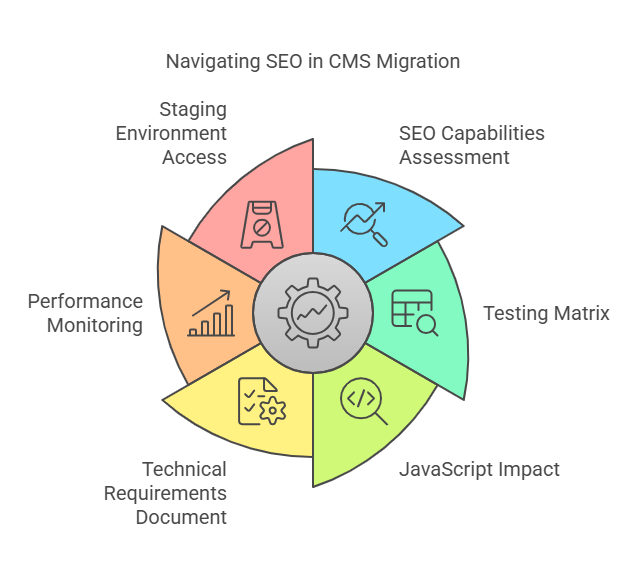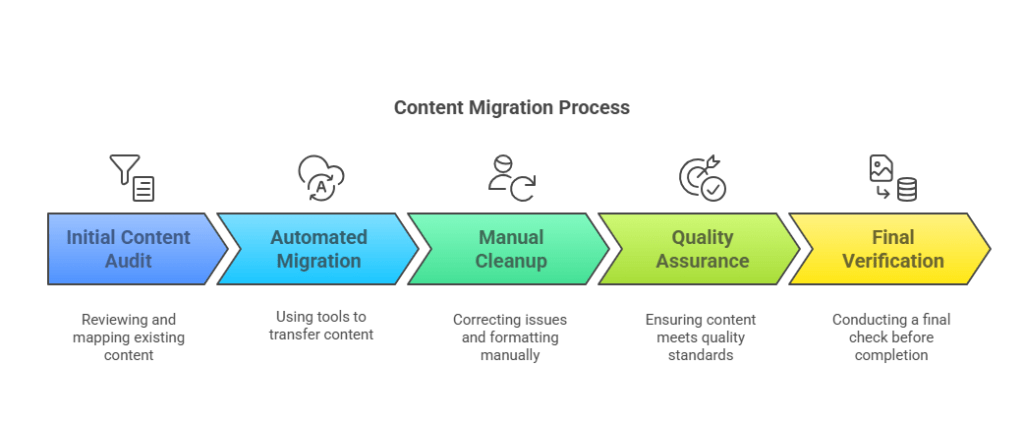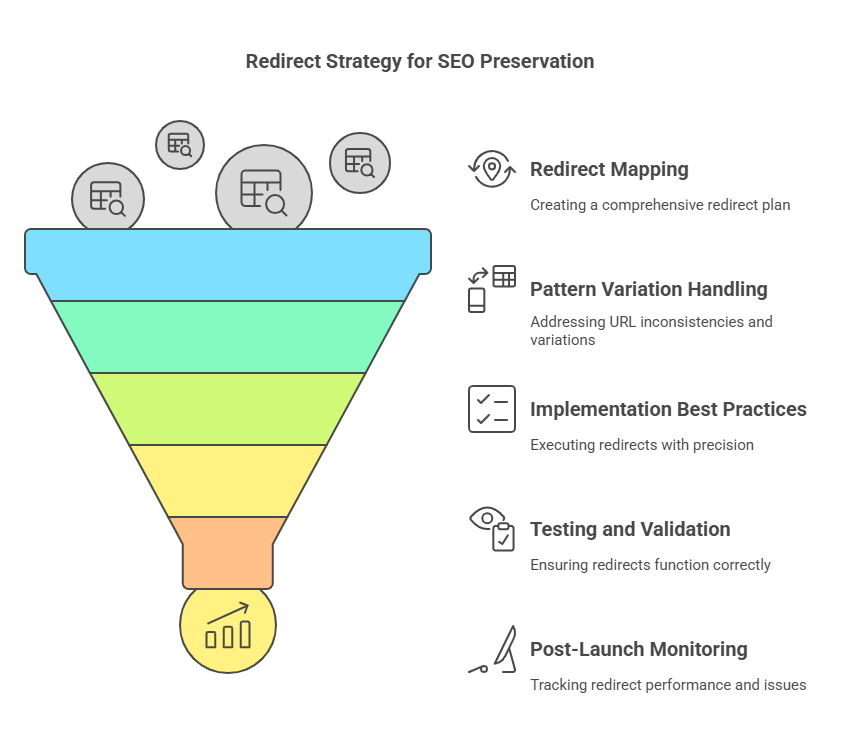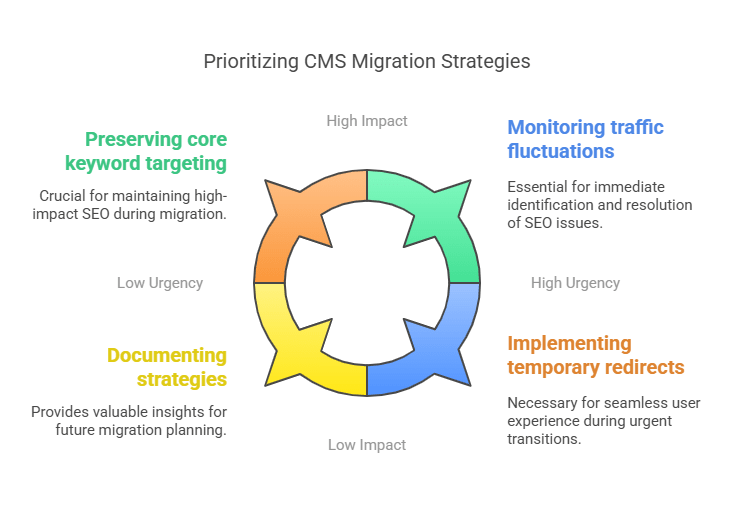I’ve guided numerous organizations through successful CMS migrations. While each migration is unique, certain challenges consistently emerge that can impact your SEO performance. In this guide, I’ll share practical insights from recent migrations to help you navigate your own platform transition successfully.

Planning Your CMS Migration Strategy
I’ve learned one truth the hard way when it comes to CMS migrations: no matter how well you plan, unexpected challenges will arise. Recently, I led what seemed like a straightforward CMS migration that is turning into a multi-month journey of discovery. But here’s the thing, with proper planning, even unexpected issues become manageable speed bumps rather than roadblocks.
Let’s start with the foundation of any successful migration: understanding your current SEO equity. Before you even think about moving content, you need a comprehensive audit of your existing site. I remember being caught off guard in a recent migration when we discovered that some of our highest-performing organic landing pages weren’t even on our initial migration list. Run a full crawl of your current site, and pay special attention to:
- Pages driving organic traffic
- Pages with valuable backlinks
- Key conversion paths
- Critical internal linking structures
- Current URL patterns and parameters
When evaluating your new CMS platform, don’t just focus on the features it advertises, dig deeper into its SEO capabilities. In one recent migration, we discovered that the new platform lacked some basic SEO functionality we had taken for granted. The time to identify these gaps is before migration, not after. Create a checklist of must-have SEO features:
- Meta data customization options
- Canonical tag implementation
- URL structure control
- Schema markup capabilities
- XML sitemap generation
- Robots.txt management
Now, let’s talk about timelines. If there’s one piece of advice I can’t emphasize enough, it’s this: whatever timeline you think you need, double it. Content migrations rarely go exactly as planned. In my experience, automated content transfers often require significant manual cleanup, internal links need reviewing, and formatting requires adjustments. Build buffer time into your schedule for:
- Pre-migration testing and validation
- Content QA and formatting fixes
- Technical SEO implementation
- Redirect mapping and testing
- Post-migration monitoring and adjustments
Cross-functional team alignment is crucial for success. I’ve seen migrations hit snags simply because different teams had different priorities. Your developers might be focused on functionality, while your content team is concerned about formatting, and your marketing team is worried about traffic. Regular check-ins with all stakeholders help ensure everyone understands the SEO implications of their decisions.
Set up comprehensive tracking before you begin. You’ll want to monitor:
- Organic traffic patterns
- Ranking positions for key terms
- Core Web Vitals
- Crawl stats
- Server response codes
- Index coverage
Don’t forget to document everything. Create a detailed timeline, assign clear responsibilities, and maintain a living document of decisions and changes. This documentation becomes invaluable when questions arise during and after the migration.
Remember, the goal isn’t just to move content from one platform to another, it’s to maintain and improve your search visibility throughout the transition. By investing time in thorough planning, you’re setting yourself up for a successful migration that preserves your SEO equity and positions you for future growth.
One final tip: create a clear contingency plan. In every migration I’ve managed, having a backup strategy for unexpected issues has proven invaluable. Whether it’s a content rollback plan or a strategy for quickly implementing missing SEO elements, being prepared for the unexpected will help you sleep better at night.
Technical SEO Considerations for Platform Transitions
The technical aspects of a CMS migration can make or break your SEO performance. I’ve learned through experience that what looks good in staging doesn’t always translate perfectly to production. Let’s dive into the critical technical considerations that will help protect your organic search visibility during migration.

First, you need to thoroughly assess your new platform’s SEO capabilities. Every CMS handles technical SEO elements differently, and assumptions can be costly. I recently worked on a migration where we discovered that our new platform handled canonical tags differently than expected, but because we caught this during the assessment phase, we were able to develop a solution before it became a problem.
Here’s what to verify in your new CMS:
- Meta data implementation options
- Canonical tag functionality
- Robots meta tag controls
- XML sitemap generation capabilities
- Schema markup support
- URL structure flexibility
- Internal linking mechanisms
- Header tag hierarchy controls
Sometimes, you’ll find that your new platform lacks certain SEO features you need. Don’t panic, this is more common than you might think. The key is identifying these gaps early so you can develop custom solutions. I’ve worked with development teams to create custom SEO modules that fill functionality gaps. While this takes extra time and resources, it’s far better than discovering missing critical features after launch.
Testing is absolutely crucial, but it needs to be systematic. Create a testing matrix that covers different content types and templates. I’ve found that SEO functionality often works perfectly for standard pages but breaks down for specific content types or custom templates. Your testing should include:
- Meta data rendering across all template types
- Canonical tag implementation
- Internal link structure preservation
- URL pattern consistency
- Schema markup validation
- Mobile rendering
- Page load performance
- Header tag hierarchy
- Image alt text preservation
One often-overlooked aspect is the impact of JavaScript frameworks on SEO. Modern CMS platforms frequently rely heavily on JavaScript, which can affect how search engines render your content. Use tools like View Rendered Source and Web Developer to verify that your content is being rendered correctly. Pay special attention to:
- Server-side vs. client-side rendering
- Content visibility in source code
- JavaScript dependency for critical content
- Load time impact on crawl budget
- Progressive enhancement support
During the transition period, maintaining critical SEO elements requires careful coordination between teams. Create a technical requirements document that clearly outlines:
- Required meta data fields
- URL structure requirements
- Canonical tag implementation rules
- Required schema markup
- XML sitemap specifications
- Robots.txt directives
- Internal linking requirements
- Header tag usage guidelines
Performance monitoring tools should be set up before, during, and after the migration. I always ensure we have monitoring in place for:
- Server response codes
- Page load times
- Core Web Vitals
- Crawl stats
- Index coverage
- Mobile usability
- Schema validation
- SSL certificate status
Remember that technical SEO isn’t just about the initial implementation, it’s about maintaining functionality as your site grows. Document all custom implementations and create clear processes for maintaining SEO elements as new content is added. This documentation will be invaluable for future content editors and developers.
One final tip: always maintain staging environment access even after launch. I’ve found it invaluable for testing solutions to technical issues that emerge post-migration without risking live site performance.
Content Migration Realities and Solutions
Content migration is often viewed as a straightforward process of moving content from point A to point B. In reality, it’s more like moving into a new house where nothing quite fits exactly as it did before. Let me share some hard-earned wisdom about managing content migrations effectively while preserving your SEO value.

The Promise and Reality of Automation
Automated content migration tools can be incredibly useful, but they’re not magic bullets. In my experience, even the best automation typically captures about 80% of your content correctly, it’s that remaining 20% that keeps you up at night. Recently, I managed a migration where our automated scripts successfully transferred the main content but missed custom formatting. There were also many internal links pointing at broken pages that needed to be cleaned up. Here’s what you need to know about automation:
- Plan for manual review and cleanup
- Test your automation on a small content sample first
- Document patterns of what transfers well and what doesn’t
- Build extra time into your schedule for unexpected formatting issues
- Create a systematic approach for quality checking automated transfers
Preserving Your Content Structure
One of the biggest challenges in content migration is maintaining your content hierarchy and internal linking structure. Different CMS platforms handle content relationships differently, and this can impact both user experience and SEO. Focus on:
- Mapping out content relationships before migration
- Documenting your internal linking strategy
- Creating a plan for handling different content types
- Establishing clear rules for URL structure maintenance
- Building a process for updating internal links
Quality Assurance: The Hidden Time Consumer
Quality assurance often takes more time than the actual migration. I’ve learned to build in substantial QA time from the start. Create a systematic approach:
- Develop a content QA checklist
- Prioritize high-traffic and high-value pages
- Use tools to automate basic checks where possible
- Implement a multi-stage review process
- Create clear documentation for your QA team
Managing Different Content Structures
Every CMS has its own way of organizing content, and sometimes you need to get creative. I’ve worked on migrations where certain content types didn’t have direct equivalents in the new system. The key is to plan these transitions carefully:
- Identify content types that need special handling
- Create alternative solutions for platform-specific features
- Document any changes in content organization
- Plan for maintaining SEO value in restructured content
- Test new content structures before full implementation
Timeline Management
Content migration timelines often expand due to unexpected challenges. Based on my experience, here’s a realistic breakdown of where time goes:
- Initial content audit and mapping: 15-20% of project time
- Automated migration and verification: 25-30%
- Manual cleanup and formatting: 30-35%
- Quality assurance and testing: 20-25%
- Final verification and adjustments: 5-10%
The Power of Phased Migration
While big-bang launches are sometimes necessary, I’ve found that phased migrations often lead to better outcomes. Consider:
- Migrating low-traffic pages first to test processes
- Moving content in logical groupings
- Building in learning periods between phases
- Allowing time for SEO impact assessment
- Making adjustments based on early results
Documentation and Training
Document everything, not just for your current team, but for future content managers. Create clear guidelines for:
- Content formatting standards
- Internal linking practices
- Meta data requirements
- Image and media handling
- URL structure rules
Remember, content migration isn’t just about moving words and images, it’s about preserving the value and relationships within your content while ensuring it works effectively in its new home. Take the time to plan thoroughly, test comprehensively, and build in plenty of buffer for the unexpected challenges that invariably arise.
Redirect Strategy and Implementation
A solid redirect strategy is crucial for maintaining SEO value during a CMS migration, yet it’s often underestimated or left until the last minute. Through years of managing migrations, I’ve learned that redirect planning should begin the moment you start thinking about changing platforms.

Building Your Redirect Map
The foundation of a successful redirect strategy is a comprehensive redirect mapping plan. Start by gathering:
- All current URLs from your sitemap
- URLs from your analytics (last 12-16 months of data)
- URLs from your backlink profile
- Common URL patterns from internal linking
- URLs from external marketing materials
One valuable lesson I’ve learned is to look beyond just the current sitemap. I once discovered that some of our highest-value pages weren’t in the sitemap at all, but were driving significant organic traffic. Your redirect mapping should be driven by data, not assumptions.
Handling URL Pattern Variations
URL patterns can be trickier than they first appear. Common challenges include:
- Trailing slash variations
- Case sensitivity issues
- Query parameter handling
- Category and tag URLs
- Pagination patterns
- Filter and sort URLs
- Legacy URLs from previous migrations
Pro tip: Always check how your organization promotes URLs across different channels. I’ve encountered situations where marketing materials, email campaigns, and social media were using different URL variations, all of which needed to be accounted for in our redirect strategy.
Implementation Best Practices
When it comes to implementing redirects, precision is crucial. Here’s what to focus on:
- Use 301 redirects for permanent moves
- Implement redirects at the server level when possible
- Avoid redirect chains
- Test redirects before going live
- Monitor redirect performance after launch
- Document all redirect rules and patterns
Testing and Validation
Never assume redirects will work as intended without thorough testing. Create a testing protocol that includes:
- Testing all redirect patterns
- Checking for redirect loops
- Verifying proper status codes
- Testing mobile and desktop versions
- Checking canonical tag alignment
- Verifying analytics tracking
Post-Launch Monitoring
Your work isn’t done once redirects are live. Establish a monitoring system for:
- 404 errors
- Redirect chain detection
- Crawl errors
- Search console coverage issues
- Traffic patterns to redirected URLs
- Core Web Vitals impact
Common Pitfalls to Avoid
Through experience, I’ve identified several redirect-related issues that can impact SEO:
- Not accounting for URL parameter variations
- Forgetting about historical redirects
- Overlooking case sensitivity
- Insufficient testing of wildcard redirects
- Not monitoring redirect performance
- Failing to document redirect rules
Tools and Resources
Leverage available tools to make redirect management easier:
- Log file analyzers
- Redirect path checkers
- Bulk URL checkers
- Crawl tools for testing
- Search console data
- Analytics reports
Recovery Strategies
Even with careful planning, you might miss some redirects. Have a plan ready for:
- Quickly implementing missing redirects
- Monitoring and responding to 404 errors
- Updating internal links
- Communicating with external sites
- Adjusting redirect rules as needed
Remember, redirects aren’t just a technical requirement, they’re a crucial part of preserving your site’s SEO equity and user experience. Take the time to plan thoroughly, test comprehensively, and monitor continuously. Your organic traffic will thank you for it.
Preserving Search Performance During Transition
Maintaining search visibility during a CMS migration is like performing a high-wire act, it requires balance, precision, and a solid safety net. Over the years, I’ve developed strategies that help minimize traffic disruptions while ensuring long-term SEO success.

Maintaining Landing Page Effectiveness
Your top-performing landing pages deserve special attention during migration. Start by:
- Identifying your critical landing pages through analytics data
- Understanding what makes these pages successful
- Creating a detailed preservation plan for each page
- Monitoring performance metrics closely
- Having contingency plans ready
Sometimes, platform differences mean you can’t exactly replicate your old pages. In these cases, focus on preserving the essential elements that drive performance:
- Core keyword targeting
- User intent fulfillment
- Content depth and quality
- Internal linking structure
- Conversion elements
Temporary Content Solutions
During migration, you might need temporary solutions to bridge the gap between old and new structures. Some effective approaches include:
- Creating interim landing pages
- Implementing phased content updates
- Using temporary redirects strategically
- Maintaining essential user paths
- Preserving critical conversion elements
Monitoring and Addressing Traffic Fluctuations
Set up comprehensive monitoring before the migration begins. Focus on:
- Daily organic traffic patterns
- Key landing page performance
- Core keyword rankings
- Conversion rates
- User behavior metrics
- Technical SEO indicators
When you spot fluctuations, have a systematic approach for:
- Identifying the root cause
- Implementing quick fixes
- Monitoring recovery
- Documenting solutions
- Preventing similar issues
Stakeholder Communication
Clear communication is crucial during a migration. Create a communication plan that includes:
- Regular status updates
- Performance reports
- Issue alerts and resolutions
- Success metrics
- Timeline adjustments
- Resource requirements
Remember to adjust your communication style for different stakeholders:
- Executive team needs high-level impacts
- Marketing team needs performance metrics
- Development team needs technical details
- Content team needs workflow updates
Recovery Approaches
Even with perfect planning, some performance dips may occur. Have recovery strategies ready for common scenarios:
- Traffic drops to specific pages
- Ranking fluctuations
- Crawl rate changes
- Index coverage issues
- Core Web Vitals impacts
Measuring Success
Define clear metrics for measuring migration success:
- Organic traffic retention
- Ranking preservation
- Conversion rate maintenance
- User engagement metrics
- Technical SEO scores
- Page speed metrics
Pro tip: Look beyond just the numbers. Sometimes, short-term metrics might dip while you’re setting up for long-term success. Keep your eye on both immediate and future goals.
Timeline Considerations
Create a realistic timeline that accounts for:
- Pre-migration baseline establishment
- Phased implementation periods
- Monitoring and adjustment windows
- Recovery time if needed
- Long-term performance tracking
Remember, preserving search performance isn’t just about maintaining numbers, it’s about ensuring your site continues to serve your users effectively throughout the transition. Focus on user experience alongside technical metrics, and you’ll be better positioned for long-term success.
A final note: document everything. The insights you gain during this migration will be invaluable for future updates and optimizations. Create a living document of: A final note: document everything. Create a living document of: all processes, challenges faced, and solutions implemented, as well as any lessons learned along the way. This documentation will not only serve as a helpful reference for your team but will also be crucial for tracking local falcon ai integration updates, ensuring that everyone is aligned and informed as the project evolves. By maintaining thorough records, you position your organization for smoother transitions with each subsequent enhancement or integration.
- Successful strategies
- Lessons learned
- Performance patterns
- Recovery techniques
- Implementation tips
This documentation becomes your playbook for future migrations and helps build institutional knowledge that benefits your entire organization.
Future-Proofing Your New CMS Implementation
Once your migration is complete, it’s time to shift focus from preservation to growth. Here’s how to ensure your new CMS evolves with your organization’s needs and stays aligned with SEO best practices.

Building a Culture of SEO
The most successful organizations I’ve worked with embed SEO considerations into their content workflows from the start. This means:
- Creating cross-functional SEO champions
- Integrating SEO checkpoints into content creation
- Developing clear escalation paths for technical issues
- Building SEO considerations into development sprints
- Establishing regular SEO training programs
Knowledge Transfer Systems
One often-overlooked aspect of CMS management is creating sustainable knowledge transfer systems. I’ve seen too many organizations become dependent on a single “SEO person” or developer. Instead, focus on:
- Creating modular training materials
- Building step-by-step process guides
- Developing troubleshooting flowcharts
- Recording platform-specific nuances
- Maintaining a shared knowledge base
Scaling Your Content Operations
Your new CMS should support growth without requiring constant technical intervention. Plan for:
- Template systems that scale
- Content modeling for future expansion
- Automated quality checks
- International market capabilities
- Multi-site management options
Innovation and Experimentation
Set up your CMS to be a platform for innovation rather than a constraint. This includes:
- A/B testing capabilities
- Structured data expansion
- New content format testing
- Performance optimization experiments
- User experience improvements
Development Workflows
Establish development practices that protect SEO while enabling innovation:
- Version control for template changes
- Staging environment protocols
- Feature branch testing procedures
- Deployment validation checks
- Rollback procedures
Future Content Strategies
Position your CMS to support emerging content trends:
- AI-assisted content creation
- Rich media integration
- Interactive content capabilities
- Personalization features
- Multi-channel publishing
Remember, a successful CMS implementation isn’t just about maintaining what you have, it’s about building a foundation for future growth. Focus on creating systems that can evolve with your needs while maintaining SEO best practices at their core.
I’m an SEO and performance marketing leader who loves breaking down complex strategies into clear, actionable insights. I have driven growth for reputable brands such as SAP, Four Seasons, BioMarin Pharmaceutical, and Rosewood Hotels in SEO and Performance Marketing strategy.

